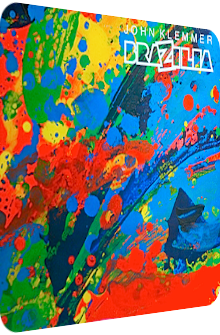
John Klemmer
Brazilia
1979
The Jazz and Fusion realms of saxophonist and composer John Klemmer (born 1946) are probably not the kinds of soundscapes Exotica experts have in mind, and true enough, if you narrow the genre down to a certain set of rules or likely occurrences, his release of 1979 called Brazilia does neither belong to the vintage Exotica phase nor the neo-Exotica revival that was started in the 90's. But if you are willed to count the synergetic depiction of technicolor Tropes to the canon, then this particular artifact is the most glowing example of Klemmer's complete works.
Three of the eight featured tracks comprise of an accentuating orchestra conducted by Ian Freebairn-Smith whose blissful strings boost the languorous sceneries to celestial realms. Likewise, the amount of seven original tracks – with one rendition of a George Gershwin classic – offers plenty of variety. Klemmer surely did not have the Exotica crowd in mind during the blueprint phase, but the allotted Latin timbre, the highly energetic teamplay as well as the many (electric) pianos, drums and guitars make this a good album that crosses several genre boundaries and can best be compared to Geoff Love’s Funk Exotica project Mandingo. The Jungle depiction is as fake as in vintage Exotica material, it is just the pool of instruments that has widened. The second half of the album is boldly romantic with a string of downbeat tunes, so even though I prefer the esprit and verve of the first half, the remaining four hammock-compatible tracks have their specific advantages as well. For a change, let me mention an unlikely, modern work of Jazz that is close enough to the Exotica genre to be considered in the vast canon.
Brazilia is opened by the eponymous title track of almost nine minutes! Launching with an opening phase of 30 seconds that comprises of utterly dreamy Fender Rhodes electric piano droplets by Jorge D’Alto in front of orchestra string washes, Klemmer’s composition moves into Jungle Jazz realms with eclectic percussion patterns by Airto Moreira and Alex Acuna, with staccato-chopped electric piano notes, warbled paradisiac flutes and a euphonious-mellow performance on the bandleader’s sax, with a fifteen-note motif being a recognizable marker that reappears throughout the arrangement. This is tropical Jazz Funk par excellence, with an overarching progression not only depicted in the track’s macrostructure, but in the way the effervescence rises with every minute. The orchestra strings are tremendously lush and transfigure the colors of the front cover in an aural way as they are injected to the ears of the listener. The strings provide the necessary mirage in the otherwise frantic, if incessantly eupeptic collage of vignettes that are loosely tied to the Exotica genre thanks to the spot-on percussion and the vibraphone-like electric pianos.
Brazilia is a beast of an opener, its long duration allows the listener to fully submerge and enjoy the technicolor landscapes. The upbeat rhythm and quick succession of ever-changing instruments make up the main attraction of this progressive centerpiece and opener, taking the Funk of the aforementioned Mandingo project to new and softer heights. You do not have the time and only want to check out one single track off Brazilia? Choose the title track!
The oxymoronic Tropical Snowflakes follows and can only be considered as a breaking device, for the tempo is tremendously decreased. Freebairn-Smith’s orchestra is missing, the focus on an intimate dreaminess becomes apparent. Oscar Castro-Neves’ sun-dried acoustic guitar resembles the Tropics, whereas Victor Feldman’s gelid electric piano unsurprisingly depicts the snowflakes. Both instruments are tied together by Klemmer’s main melody on the sax, a free-spirited, potentially improvised spiral of oscillating silkiness. While the dreamy Heartbreak meshes Jorge D’Alto’s warm piano drops with equally snugly orchestra strings, synth washes, laid back tick-tocking percussion and even a wondrous accordion (synth?) that harmonizes well with the tenor saxophone, George Gershwin’s Summertime is the only rendition of a Jazz standard on this album and offers the most reduced setting with lots of sustain phases and micro pauses through which the reverberation of Klemmer’s sax and the Balearic acoustic guitar fade into the distance. The Latin transformation works decidedly well, and the arrangement evokes a tropical Summer night. The various strings would have been counterproductive devices in this case, as the hollowness of the ensuing space is the right ingredient for delivering a nocturnal setting.
Tender Storm is a particularly romantic track, one of many in a row as the album winds down. However, it is performed in a less kitschy way than expected, with Klemmer's saxophone playing in legato for the first time on this release. The high-tone piano sprinkles add plasticity and dreaminess to the arrangement, and it is once again the colorful range of the orchestra strings that provides a resplendent background for the lead instruments to shine. The fusion of electronic molecules with classic instruments was often considered a bewildering and alienating choice in the realms of Jazz, but that is the way these kinds of synergetic fusions tendentially work. The 70's turned out to break the ice in this regard. Tender Storm, in the end, is over-exposed, but that is by now expected and fends off an overly clichéd aura or particularly syrupy riff.
The following Copacabana is John Klemmer's own creation, despite its title that is shared with Barry Manilow's cut. Dark trombones mesh with mellifluous piano chords and a sunset-evoking dreaminess on the saxophone. The penultimate offering Bahia sets the listener yet again on another deliberately wrong track, for it is not based on Ary Barroso's eponymous world hit, but proves to be an original tune with a dreaminess akin to the two previous offerings: of particular note are the scintillating electric piano notes and the melancholic saxophone melodies that create a lush, moon-lit beach panorama. Klemmer's Bahia unfortunately lacks a bongo or conga aorta that would have augmented the aqueous scenery and evoked tropical glitz. In this incarnation, however, it is not overly exotic. The final My Love Has Butterfly Wings ('79) explicates the truest form of a music-driven nocturnal phantasmagoria with echoey saxophones, enigmatic wind chimes and wafting organ scents in the background. Despite the occasionally dynamic cymbals, there is room enough for the dulcet mélange to breathe. The saxophonist cleverly ships around sugar-loaded riffs, and yet am I disappointed about the setup in comparison to the much more playful, orchestra-laden and dynamic first half of Brazilia. But that is up for debate.
Brazilia is perfectly bound in Fusion and contemporary Jazz realms, but don't underestimate its exotic traits and Jungle ingredients that make it partially interesting to Exotica fans. This assertion can be especially applied to its first half due to the gargantuan title track whose energetic percussion, staccato intertwinings and grand orchestra strings make up a highly enjoyable and uplifting journey through colorful climes. Of similar success is the non-clichéd timbre of the Balearic guitars and the accordion-like synthesizers in the following tracks. The second half of the album falls off in these regards, with four dreamy and overly smooth romantic songs in a row. Don't get me wrong, there is nothing wrong with the concept of tranfiguring beauty; whole albums were created with these moods intact, Arthur Lyman's moony Hawaiian Sunset (1959), Martin Denny's balmy The Enchanted Sea (1959) and Gene Rains' similarly titled Far Across The Sea (1961) being but three examples.
However, in the case of Brazilia, the second half of the album cannot compete with the first four tunes, neither in terms of the pool of instruments, nor in regard to the melodies and energy. Vintage Exotica fans might be put off by the album for its electronic slivers in the forms of Fender Rhodes organs and the perpetually escalating feeling of uplifting happiness whose state is maintained, nurtured and boosted by the various euphonious, dynamic and occasionally syrupy hooks, riffs and bridges. But all in all, Brazilia is a good Jungle Jazz album and exotic enough to be featured here. As stated above, I prefer the first string of four tracks, but your mileage may vary, and decidedly so if you prefer a more intimate legato depiction of the Jazz genre.
Exotica Review 158: John Klemmer – Brazilia (1979). Originally published on Dec. 15, 2012 at AmbientExotica.com.
